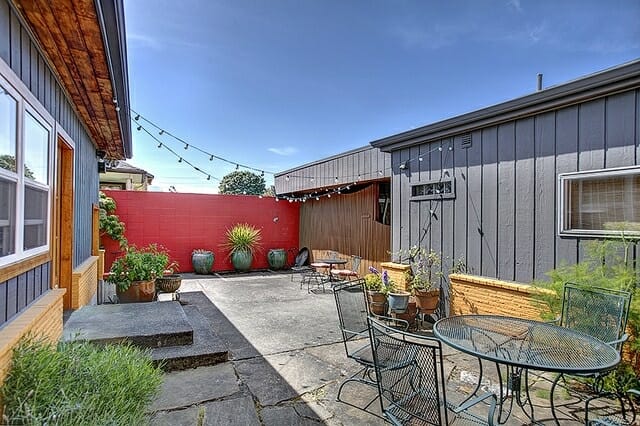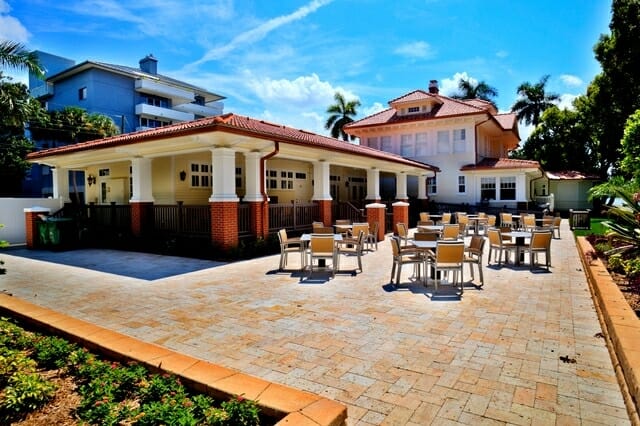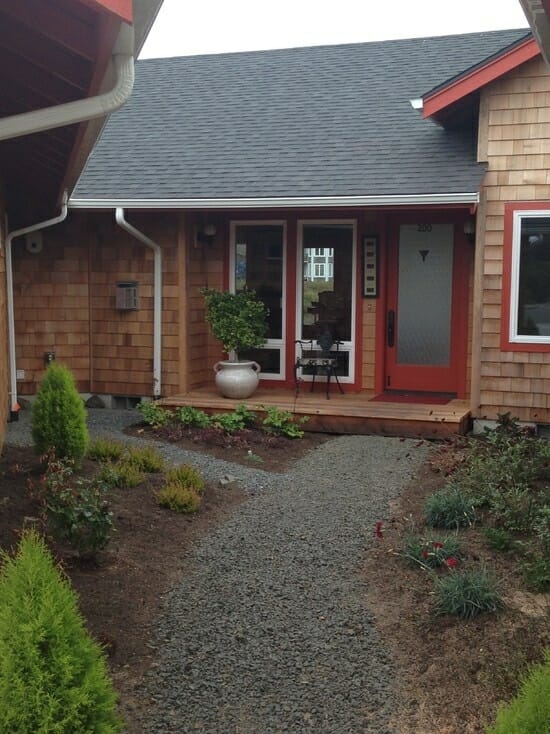Are you doing a home improvement project?
Modernize can pair you with three to four pros in your area, so you can compare options and save time and money.
An outdoor patio can be one of the most relaxing spots in your home. With comfortable seating and a great view, a patio can easily become an outdoor living space for you and your family.
Patios can be created from a variety of materials, and the best choice for your home depends not only on how much you want to spend and how much work you want to do, but also on the climate where you live and the style of your home.
Patio Building Materials
Concrete
Concrete is one of the more commonly use patio materials—but this doesn’t mean it has to be boring. There are plenty of ways you can add style and personality to a basic concrete patio. If you have a standard, builder-grade concrete patio, staining it is an easy weekend project that give it a custom look. Stain is available in many different colors, so you’ll have no problem finding one that complements your home. Sealing the concrete after staining ensures that your patio will weather well and be less likely to need repairs each season.
If you’re building your patio from scratch and are attracted to the affordability of concrete, you can take your patio plans a step further by stamping the concrete. Concrete can be stamped to resemble a number of other materials, including brick, slate, flagstone, tile and wood. Often, stamped concrete costs considerably less than the material it’s imitating (and, in the case of wood, weathers the elements quite a bit better, too). Stamped concrete will give your patio a more natural look and help it to blend in better with your yard.
Natural Stone
Natural stones like flagstone, bluestone, slate, and limestone are another popular choice for patios. These large, flat stones will give your patio a natural, rustic feel. Like other natural stones, regular cleaning and care will keep your flagstone patio looking in tip-top shape year after year. For best results, your patio should be sealed, waterproofed, and cleaned thoroughly twice a year.
One of the advantages of a natural stone patio is that it can blend in very easily with the rest of your landscaping. Laying the stones further apart and allowing a ground cover, like creeping thyme or Calgary carpet juniper, to grow in-between helps create the feel of a secret garden.
Clay Brick
Brick patios call to mind the cobblestone streets of yore and give your patio a decidedly old world vibe. If you want your patio to remind you of your trip to Italy, brick is the way to go.
Find the Right Contractor for Your Project
Whether you’re ready to begin your project now or need some expert advice, our network of contractors are here to help. With a few simple questions, we’ll find the best local professionals for you
Unfortunately, while a brick patio may look great, it does come with some maintenance issues, depending on where you live. The porous nature of bricks means they retain moisture, so if you live in a freezing climate, you’re likely to find yourself replacing cracked and crumbling bricks each spring. If you want the look of brick with slightly less maintenance, stamped concrete might be your best bet.
Still, bricks are affordable and easy to lay down in a variety of patterns to complement the style of your home and yard. Bricks can be set further apart to allow a ground cover, such as moss, to grow in between. Like flagstone, brick patios should be sealed to protect against damage from the elements.
Concrete Pavers
Concrete pavers are similar to clay bricks, but with a few advantages. For one, concrete pavers are often considerably less expensive than bricks—an important consideration if you have your heart set on a large patio. Concrete pavers are also available in more design and color options, so you can really get creative with your patio design. They can also be easier to install than bricks, since concrete pavers are more uniform in size thanks to the manufacturing process.
Like a brick patio, a concrete paver patio will wear best when it’s been coated with sealant. Concrete pavers can be significantly less durable than bricks, though that can vary by manufacturer. In general, a concrete paver patio will not last as long as a brick patio. Still, thanks to the wide variety of options, concrete pavers are e a great choice as a patio material.
Gravel
Gravel is by far the easiest type of patio to install, and you have many choices, from decomposed granite to pea gravel. Gravel is also a great choice for any walkways you want to install in your yard. If you install your gravel patio over a fabric landscape liner, you shouldn’t have any problems with weed growth.
Of course, gravel isn’t the easiest surface to walk on, and you will find yourself needing to “top off” the patio with another bag of gravel each season or two. Still, for the price and ease of installation, it’s a patio material worth considering.
Find the Right Contractor for Your Project
Whether you’re ready to begin your project now or need some expert advice, our network of contractors are here to help. With a few simple questions, we’ll find the best local professionals for you
Reviews from Real Homeowners
Welcome to Homeowner Resources! We are the Modernize blog. Modernize pairs more than 3 million homeowners a year with pre-vetted contractors in their area. This blog started because we believe homeowners should know everything about their homes, from how their HVAC works to which front door colors they might love. On Homeowner Resources, you can find information on every part of your home, right down to how you can negotiate with contractors to get the best price. Here's more about the blog.
Need a contractor? Learn more about how Modernize finds the right pro for you.








